Every spring, 80% of the world’s sandhill crane population ends up just five hours away from me. At its peak, about a million cranes find their way to the Platte River near Kearney, Nebraska during their migration north. So last week I did my own two-day migration north to photograph them.
The first step before any successfull outing like this is research. Are the birds there now, and if so, how many? What types of behavior might I see? When are they most active, feeding and resting? How skittish are they about having people nearby? I always start with the internet, and after learning about the animal, research the area I’m headed.
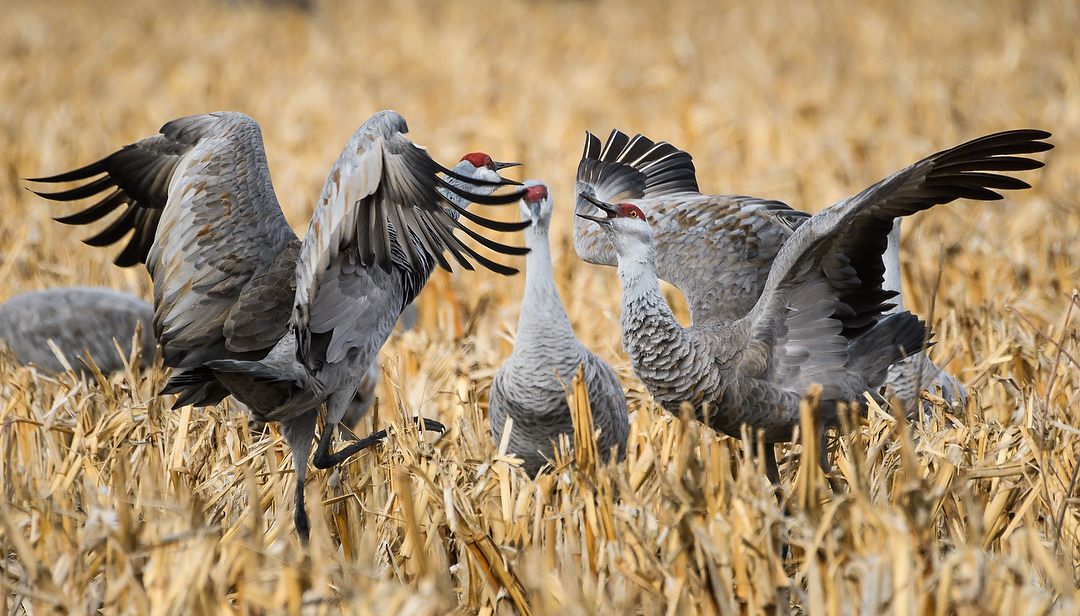
I read that Sandhill cranes are famous for their dances, so knew I wanted to make a nice photo of that. This turned out to be my favorite, as it has everything – moment, expression, clean background, good light and not too far away. Plus a bonus of a third crane watching with a “What the?” face. Nikon D500, Aperture Priority, Sunny white balance, ISO 900, 1/1250 at f/8 in Matrix metering, 0.0 EV, Nikkor AF-S 200-500mm f/5.6E ED VR lens with Nikkor TC14-e III teleconverter for 650mm.
A quick search found two places there that are unique, and all about the cranes: the Iain Nicolson Audubon Center at Rowe Sanctuary and the Crane Trust Nature & Visitor Center. Between their websites and Facebook pages (where more up-to-date daily information can be found), I was able to confirm that an estimated half-million cranes were already there, with more on the way. There were also maps, and combining that with Google Maps satellite view, I was able to locate a number of viewing platforms in the area. The final two steps in planning were to check the local weather forecast and book a hotel room.
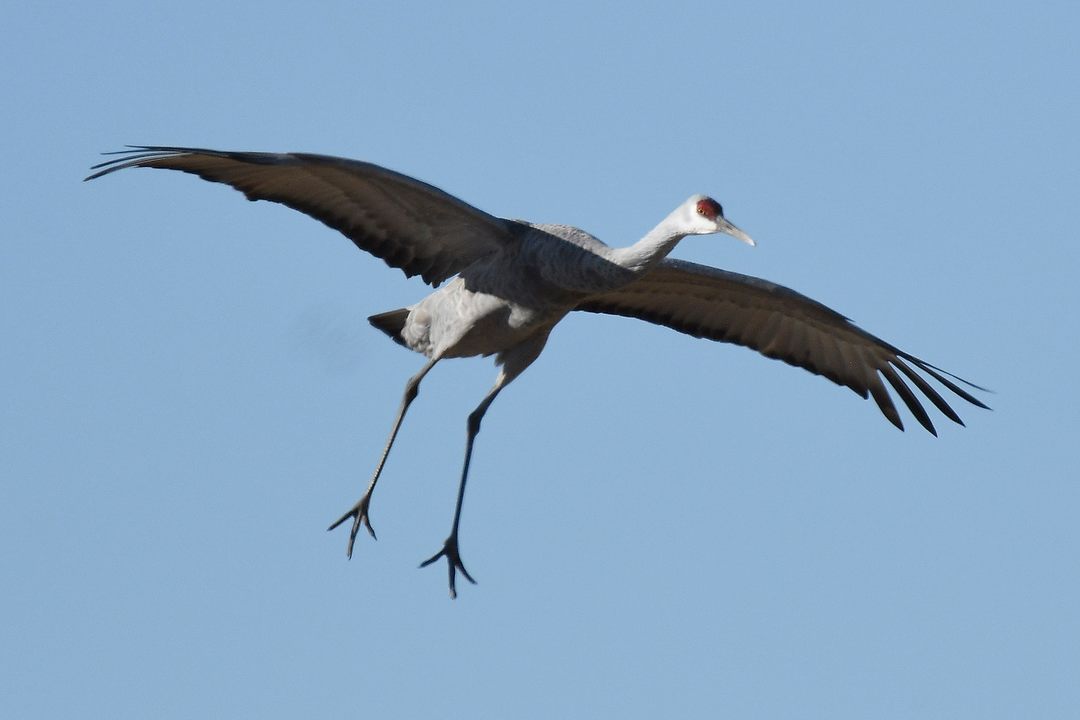
One of the key things you learn quickly when doing bird photography is that they prefer taking off and landing into the wind, just like planes. So you want to put the wind to your back, so they’re coming towards you when doing that, like this crane on approach with its landing gear down. Nikon D500, Aperture Priority, Sunny white balance, ISO 640, 1/2000 at f/8 in Matrix metering, +0.7 EV, Nikkor AF-S 200-500mm f/5.6E ED VR lens with Nikkor TC14-e III teleconverter for 700mm.
I wasn’t teaching any online classes last week, so that gave me a window to work with. Thursday was forecast to be sunny, with clouds moving in Friday followed by rain on the weekend. Last-minute hotel reservations are normally hard to find in Kearney during the crane migration, but thanks to COVID, getting a room the day before was easy. So at 6:30 Thursday morning I hit the road, which would get me into the area around noon.
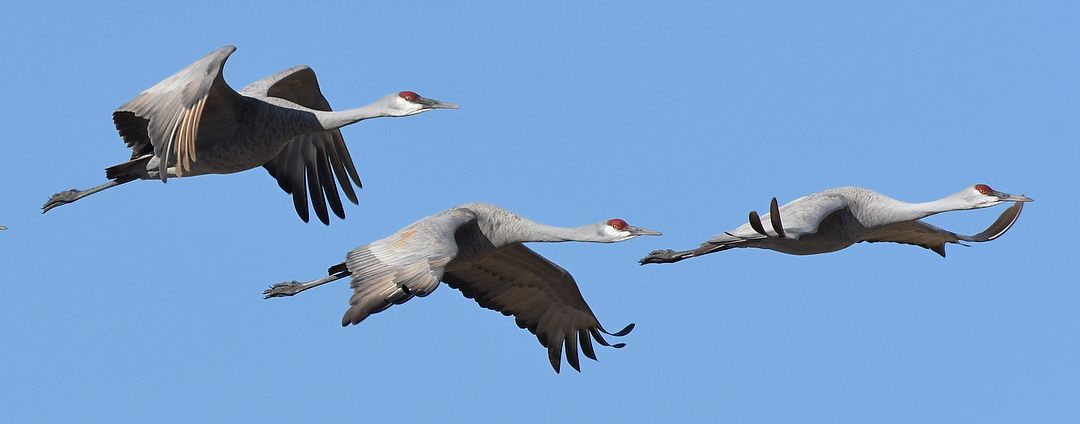
I shot lots and lots of frames of the cranes in flight, as I love the patterns they create, plus the different shapes their wings make. Nikon D500, Aperture Priority, Sunny white balance, ISO 1000, 1/1600 at f/11 in multi-segment metering, +0.7 EV, Nikkor AF-S 200-500mm f/5.6E ED VR lens with Nikkor TC14-e III teleconverter for 700mm.
There are two key reasons the cranes choose this area as a rest stop on their way north. One, the Platte River is shallow, wide and braided, which makes for a perfect (meaning safe) area for them to rest overnight. And two, the surrounding cornfields are a good source of waste corn, where they can feed and bulk up before continuing their journey.
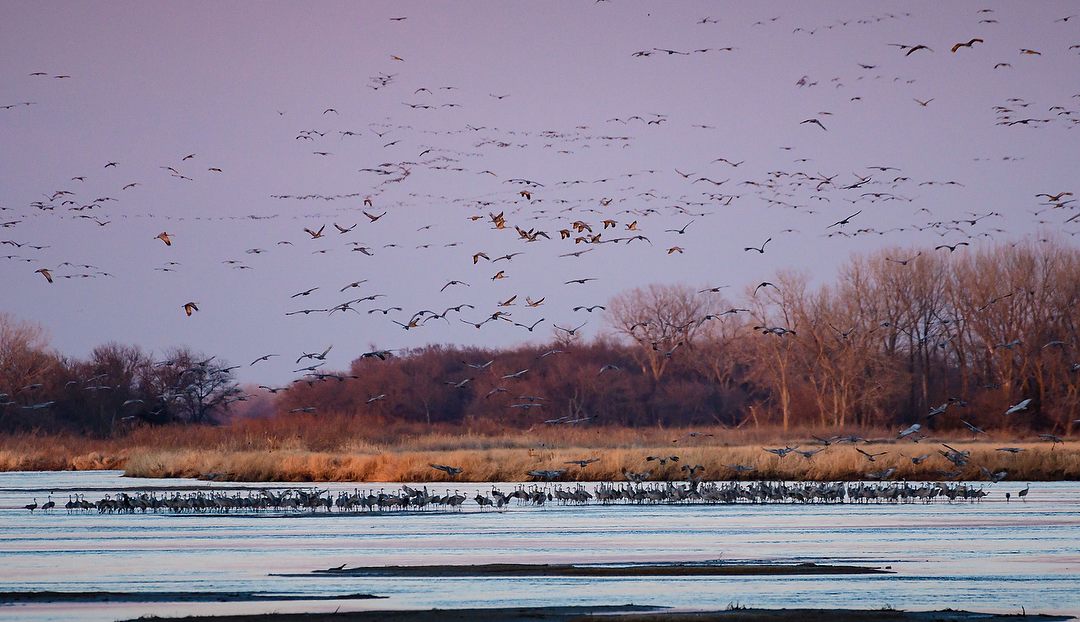
The cranes returning to the river for the night. Nikon D500, Aperture Priority, Sunny white balance, ISO 1600, 1/800 at f/5.6 in Matrix metering, 0.0 EV, Nikkor AF-S Nikkor 200-500mm f/5.6E ED VR lens at 500mm.
That meant I spent Thursday afternoon driving the back roads among the farms in the area, looking not just for cranes (they’re pretty much everywhere), but for ones close enough to the road for a good picture (and, they needed to be where I could pull my car off the road safely). Of course, in addition to being close, I wanted a good background (clean, no distractions), good light (side-light is more interesting) and action, not just feeding. Cranes are famous for their dances, often leaping into the air, tossing things, and performing mating poses with other cranes. So over the course of the afternoon I drove about a hundred miles, also checking out the various viewing platforms and deciding where I wanted to be for sunset, as well as sunrise Friday morning. And that involved knowing exactly where the sun would set and rise.
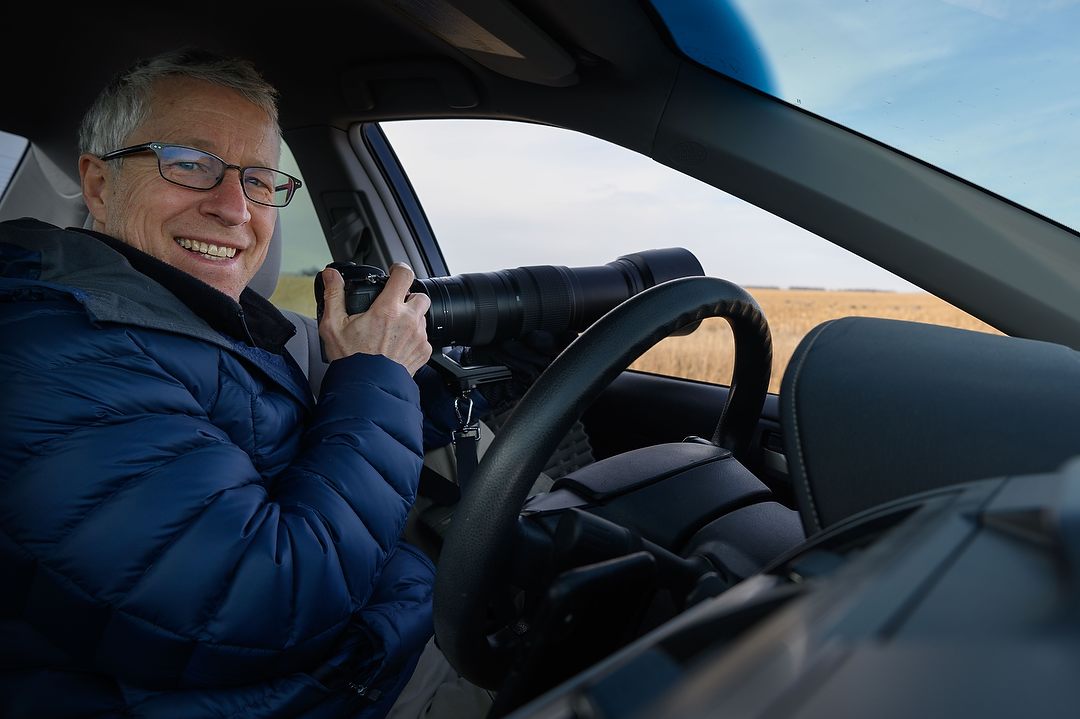
The birds, used to being hunted, are understandably leery of people. If you stay in your car, though, they’re less likely to move away. This is how I spent most of my time shooting. Nikon Z 6 II, Auto Daylight white balance, ISO 125, 1/250 at f/5.6 in Matrix metering, 0.0 EV, Nikkor NIKKOR Z 24-200mm f/4-6.3 VR lens at 24mm.
There are a lot of smartphone apps designed for photographers, and my favorite is PhotoPills. Using it in “Augmented Reality” mode, I could see where the sun would set and rise, which allowed me to make informed decisions on where to be at those times of day. For sunset, I chose a platform at the east end of the area, and sunrise decided to be at Fort Kearny State Recreation Area, to the west. It has a pedestrian bridge over the river, about a quarter-mile from the parking areas. There’s a self-serve entrance station where you can pay the $8 fee. That’s good until noon the following day, so it allowed me to visit and scout the afternoon before as well as return early the next morning.
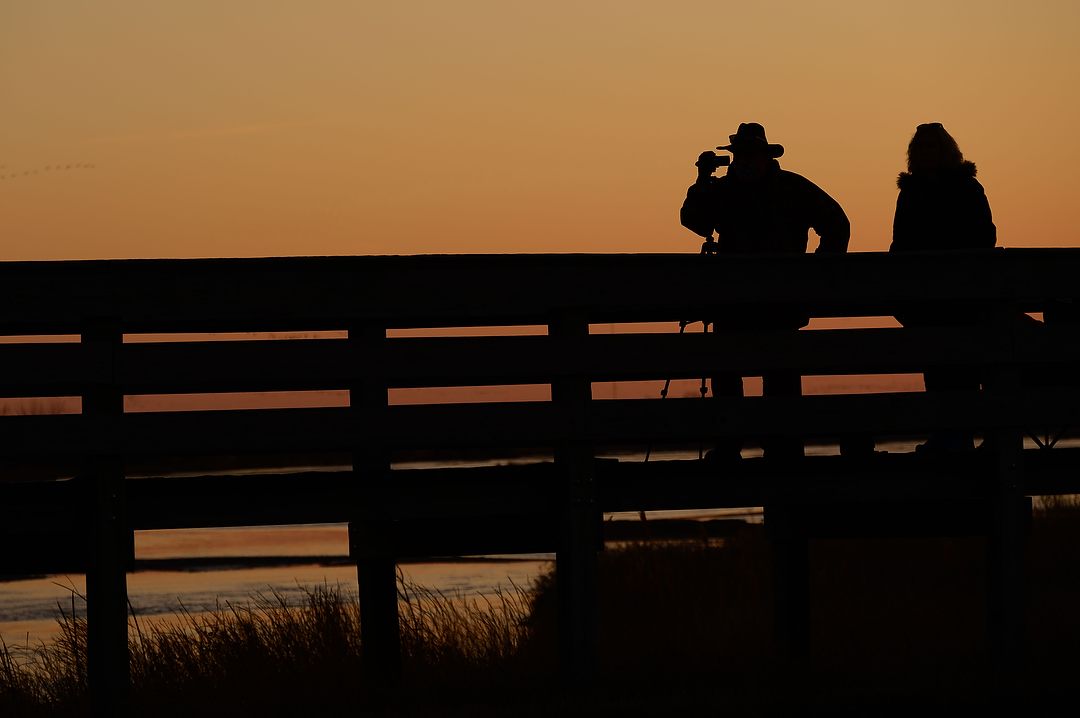
Lots of people visit to see the migration, so I wanted to include at least one photo showing that. Nikon Z 6 II, Aperture Priority, Sunny white balance, ISO 100, 1/125 at f/6.3 in Matrix metering, -1.3 EV, Nikkor Z 24-200mm f/4-6.3 VR lens at 155mm.
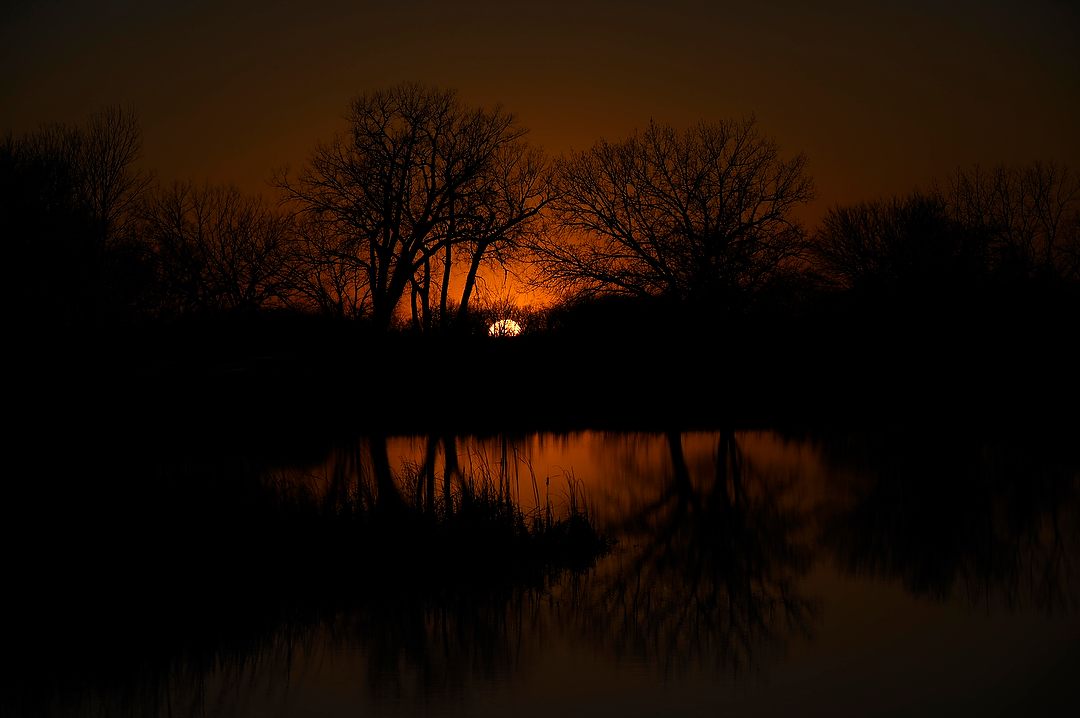
Beautiful sunset, though no cranes in that direction. But why let a nice sunset with a good foreground go to waste? The pond here was also part of the reason I chose this area for my sunset shoot. Nikon Z 6 II, Aperture Priority, Sunny white balance, ISO 100, 1/2000 at f/9 in Matrix metering, -2.7 EV, Nikkor Z 24-200mm f/4-6.3 VR lens at 115mm.
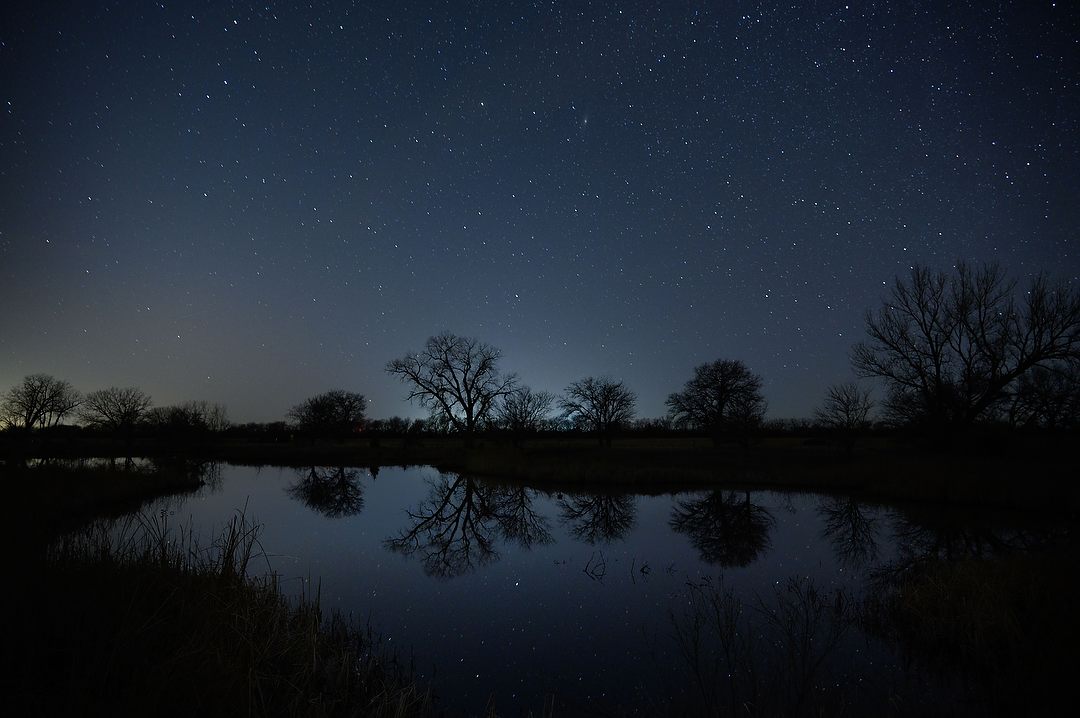
And this is why I wanted to be near the pond for sunset. I always try to find as many different opportunities for photos as I can each time I go out. While this trip was all about the cranes, I had hoped to find a good location, like this, to do a night photo while there as well. Nikon Z 6 II, Manual, 3800K white balance, ISO 2500, 30-seconds at f/4 in Matrix metering, -1.7 EV, Nikkor Z 24-200mm f/4-6.3 VR lens at 24mm.
That first day I stayed out past sunset, did a little night photography and then returned to my hotel a bit after 8pm. After downloading images and charging batteries, I hit the sack. Up at 5:30 Friday morning, I returned to that pedestrian bridge in order to be there before sunrise (around 7am). In photography, being early is almost never a problem. Being late can mean a missed photo opportunity. After sunrise, I made a quick trip back to the hotel for their sack breakfast and check-out. Then I spent the rest of the morning driving more of those gravel roads around the fields, and by early afternoon was headed home.
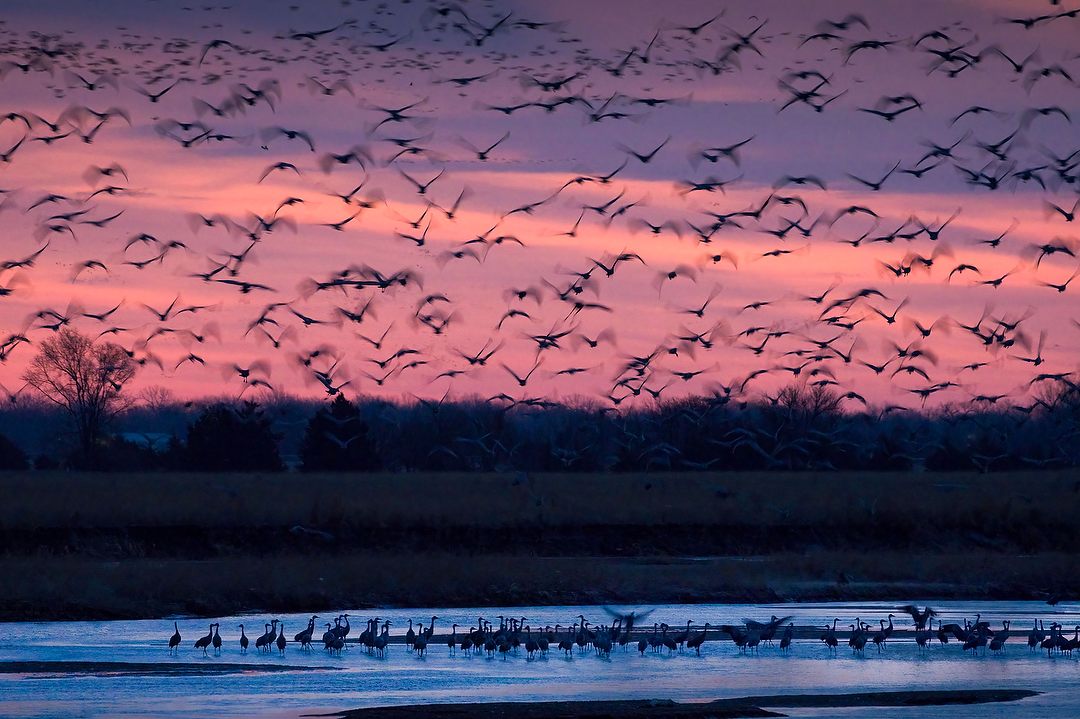
While sunrise wasn’t until around 7am, I arrived at the pedestrian bridge a little after 6, and was glad I did. Even then, the cranes were starting to leave the river. This photo was taken at 6:25am, and they were all gone well before the sun broke the horizon. I was able to shoot this at 1/20 second with my 200-500mm lens thanks to two things: one, I braced it on the bridge railing, and two, the lens has Vibration Reduction, which helped to compensate for some movement. The slow shutter speed also resulted in a nice effect, blurring the cranes in flight without blurring those standing in the water. Nikon D500, Aperture Priority, Sunny white balance, ISO 3200, 1/20 at f/5.6 in Matrix metering, -1.3 EV, Nikkor AF-S Nikkor 200-500mm f/5.6E ED VR lens at 320mm.
My primary camera and lens combination was the Nikon D500 and Nikkor 200-500mm f/5.6 lens. That camera has one of Nikon’s best autofocus systems (meaning extremely fast and accurate), shoots at up to ten frames-per-second and uses an APS-C sensor (“DX” in Nikon’s terms). What I often refer to as a “cropped” sensor, it gives me a 20-megapixel image, but with a narrower angle of view (1.5X) than a “full-frame” sensor would. For example, to get what I see through the viewfinder of my D500 with the 200-500mm lens using a full-frame camera, I’d need a 300-750mm lens. That’s the main reason I prefer Nikon’s DX cameras for wildlife photography. For autofocus settings, I used Dynamic 72 most of the time for birds in flight, and single-point when they were on the ground. And I kept the Autofocus Mode to AF-C (continuous), so it would track the action after I acquired focus.
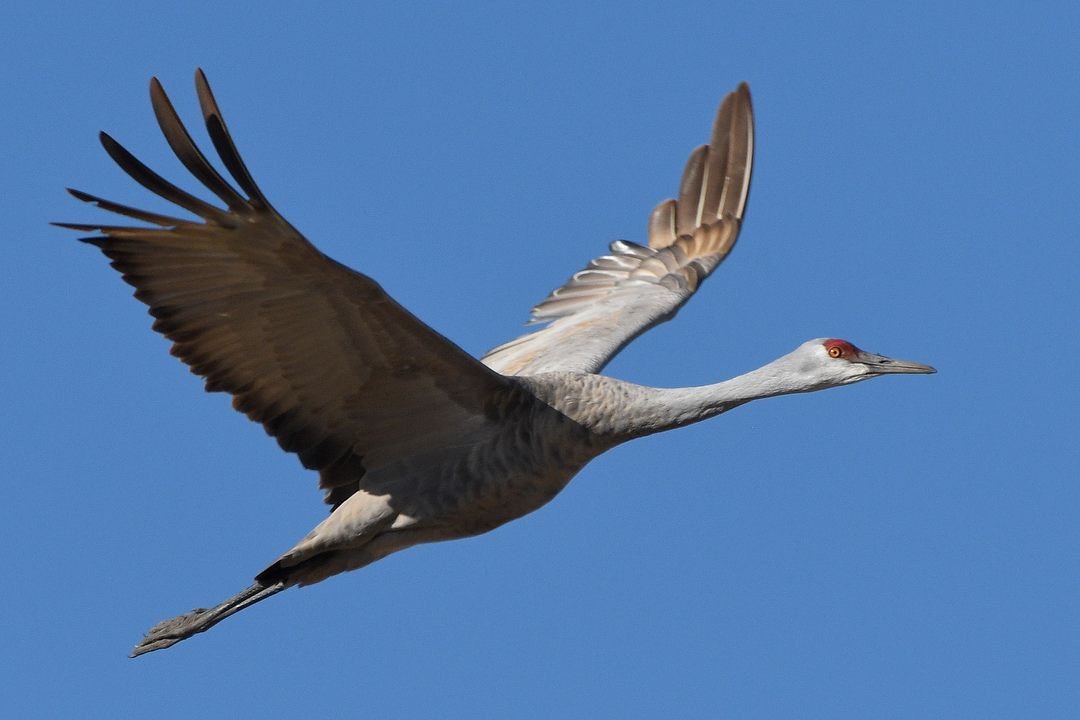
I made LOTS of photos like this, but the combination of light and shadow, good wing position and blue sky made this one better than most. Nikon D500, Aperture Priority, Sunny white balance, ISO 900, 1/1600 at f/11 in Matrix metering, 0.0 EV, Nikkor AF-S 200-500mm f/5.6E ED VR lens with Nikkor TC14-e III teleconverter for 700mm.
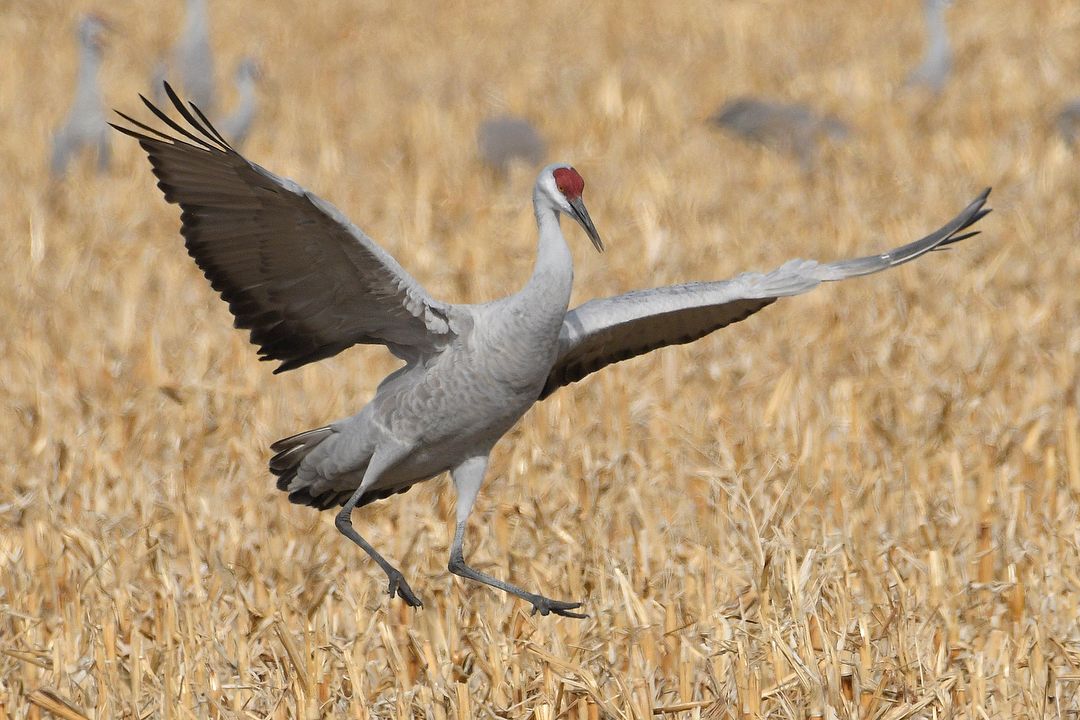
Another dancer. Again, this type of action was my #1 priority among the photos I wanted to come back with, and over the course of about ten hours shooting, I only had a couple of opportunities that resulted in good photos. The rest of the time I was too far away, the action didn’t last long enough, the background was bad or other birds were blocking the dancer. I did a lot of cursing under by breath on this trip! Nikon D500, Aperture Priority, Sunny white balance, ISO 900, 1/1600 at f/10 in Matrix metering, 0.0 EV, Nikkor AF-S Nikkor 200-500mm f/5.6E ED VR lens with Nikkor TC-14e III teleconverter for 700mm.
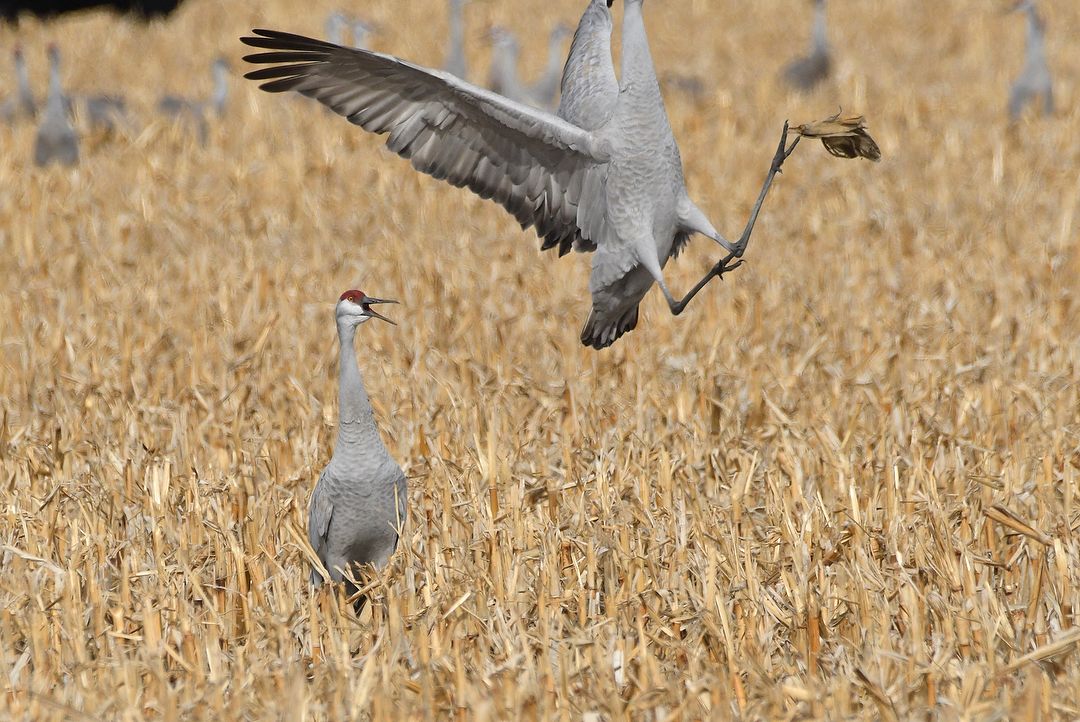
And then there were times like this, where my framing and the crane’s dancing weren’t on the same page! Nikon D500, Aperture Priority, Sunny white balance, ISO 900, 1/1600 at f/10 in Matrix metering, 0.0 EV, Nikkor AF-S 200-500mm f/5.6E ED VR lens with Nikkor TC14-e III teleconverter for 700mm.
For exposure, as is my preference, I stayed in Aperture Priority. I then used Auto ISO to allow the ISO to shift in order to maintain a fast shutter speed. For birds in flight, I set the Auto ISO menu to keep the shutter at 1/2000, or occasionally 1/1650. If they were on the ground, I’d often drop that to 1/1250 or lower.
After downloading the 2400 frames shot over those two days, I went through and marked any photo I wanted to keep, then deleted the rest (Photo Mechanic makes that an easy and quick job). What remained were about 600 images. Now, going back through them more slowly, I chose about 30 that I really liked, and you’ve seen some of those here.
Am I done with sandhill cranes? For this year, yes, I won’t be able to return there before they leave. But next year, if the weather and time cooperate, I sure hope to make another trip. Not just for the photos, but for the experience of witnessing one of nature’s great shows. And if you have the chance, I urge you to do the same. You won’t regret it.
– Interested in learning more about how I research and do Wildlife and/or Night photography? Check out the live, online classes I’m teaching, at this link –
(If you like this story, please share it with your friends and let them know about the links on photography that I post on my business Facebook page. I’m also on Instagram and Twitter, @reedhoffmann. And if you’re curious about the workshops I teach, you can find them here. And, you can subscribe to this blog on my home page.)

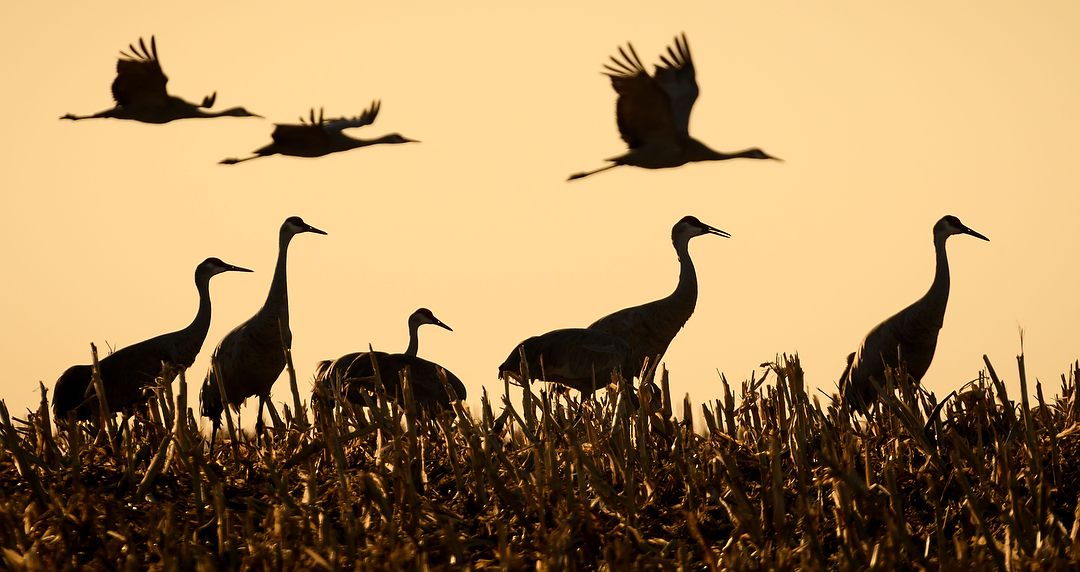
Absolutely charming. Those birds know how to have a good time. All great photos; first one might be the most amazing.
Great photos Reed. Looks like a great trip. Thank you for your sharing. 📷😎👍
Great story & images Reed!